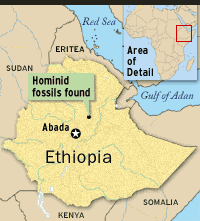This film also relates to Australopithecus afarensis and the methods
of archaeological discovery and interpretation. Note how archaeologists
and allied specialists work in the field
Terms / Concepts
- anatomy
- mandible
- innominate bone (side of the pelvis)
- saggital crest
- supraorbital tori (brow ridges)
- knuckle walking (not a stage that hominids
have gone through)
- methods
- hominid
- upright posture -- bipedalism
(note posture and locomotion)
- provisioning hypothesis
- Owen
Lovejoy
- There may have been a change from the males "notifying"
females of a food source to actually bringing them food
- range of variation
- "primitive" = "ape-like"
- "African apes" = gorilla and chimpanzee
Notes
- The expedition first found a knee joint in 1973, the first
year of fieldwork at Hadar
- Lucy
in 1974
- and the "First Family" in 1975 at Locality 333
- Lucy,
a 40% complete skeleton is no longer the oldest and most complete
hominid
in the world
- The earliest probable hominids now include
- About halfway through the first reel, as they are inspecting
a new fossil find, Don Johanson says something like "It's amazing
when you think that three and a half million years ago there were
humans living on this same locality." (He means here, "hominids,"
rather than "humans," not any fossils from the genus Homo)
- Archaeology has changed from individuals doing small projects
and looking at "a few hundred specimens" by themselves
to large multidisciplinary teams of international scientists doing
coordinate excavations involving "hundreds of thousands of
specimens."
- The 1975 International Afar Research Expedition,
for example, took 15 science specialists to the field
- Large collections of fossils, like you see in the scenes from
the Cleveland Museum labs, allow anthropologists to understand "range
of variation"
- With the Hadar "First
Family" collection from Locality (Site) 333, "there is a "gradient"
from very large to very small
- that is, there are fossils that "'span
the gap' in terms of size, between large and small"
- The brain,
jaws, teeth and dentition are very "primitive" (i.e., ape-like
- Unexpected sequence: bipedalism
(3.7 mya) --> tool
manufacture (2.4 [2.6] mya) --> brain
expansion (1.8 mya)
- Homo erectus dates back to 1.8 mya
- What was in their environment that favored upright walking?
- No other animals' bones other than hominid
were found at Locality (Site) 333
- The paleontologists found
only fossil hominid
bones, including over 200 specimens of 15 individuals (men, women,
and children)
Cultures / People
Sites
Individuals
Publications / Bibliography
- Johanson, Donald C.; and Edey, Maitland A. 1981. Lucy: The
Beginnings of Humankind. NY: Simon and Schuster.
- Leakey, Richard E.; and Lewin, Roger. 1978. People of the
Lake: Mankind and Its Beginnings. NY: Avon.
|


